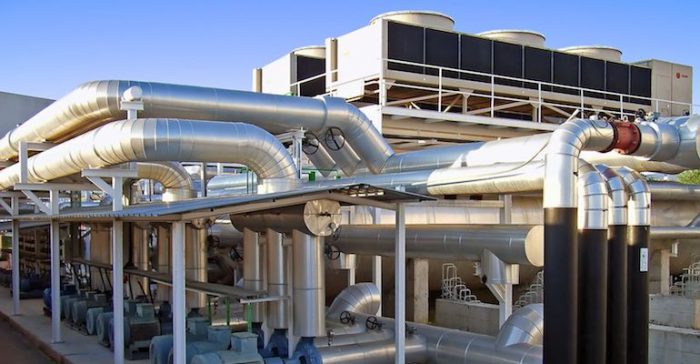Mechanical CHP to the Rescue
Why the “P” in CHP Doesn’t Always Stand for Electric Power
Written by Dale Desmarais, Director of Business Development, Tecogen, Inc., April 8, 2018
If you live in a large city or you are involved in energy, you’ve probably heard about CHP. CHP stands for combined heat and power, also known as cogeneration or cogen. When most people think of the P in CHP (for power), they probably think of electric power. That is because the prime mover, or engine, in a CHP system is most commonly connected to an electric generator that produces power and delivers that power to the building to use on-site. In this application, heat is simultaneously recovered from the engine in the form of hot water or steam and delivered to the building’s boiler loop, which is then delivered to useful loads in the building. These two energy outputs (hot water and electricity) are derived from a single fuel source, and most commonly that source is natural gas.
Definition of CHP: The simultaneous production of shaft power and heat. A prime mover (in many cases, an internal combustion engine) turns a shaft to produce shaft work, and heat is recovered from the prime mover and purposefully reused.
By definition, the “power” in CHP is referring to shaft power, and this is where the benefits of mechanical CHP can be applied. As an alternative to turning a generator to create electricity, the shaft power can be used to drive a compressor in a vapor compression cycle. In this mechanical CHP application, the output is cooling, delivered through a chilled water line. Because the system is still using a natural gas engine, it can recover the heat from that engine and provide hot water to the boiler loop as well as the chilled water to the building’s cooling loads. Again, two forms of energy (hot water and cold water) are derived from a single fuel source: cogeneration.

Hybrid Mechanical/Electric Chiller. Photo credit: Tecogen
The gas cooling market is a rapidly growing segment in the HVAC industry due to many factors:
- Rising costs of electric cooling – Electric tariffs remain high and are generally increasing. This is driven largely by the increase in the demand charges and time of use (TOU) rates.
- Refrigerant issues – Many old formula refrigerants like R22 have become (or are becoming) obsolete, and today’s codes and regulations are raising the cost to keep these older styles in use. Additionally, there are associated health risks with these older products.
- Incentives – Many utilities are offering incentives for using gas cooling. In Connecticut, utilities offer $300/ton, $350/ton in New Jersey, and $600/ton in NYC and custom programs in other states (like Massachusetts).
- Utility upgrades – There has been long-term pressure for infrastructure upgrades that will be funded by the ratepayers.
- Reliability – It has been shown over and over that when severe weather occurs, the natural gas delivery infrastructure is significantly more reliable than the electrical infrastructure.
In addition, gas cooling is proving more efficient because the peak seasons for electrical and gas usage from May to October are inverse. By using gas to cool, facilities are relieving pressure on the electric utility during the summertime peak and reaping the financial rewards. (See figure below.)

There are thousands of facilities that have utilized gas cooling technology; some of these systems have even been around for over 30 years. And the current combination of improved energy pricing, capacity restraints, heat recovery capability, and CO2 reduction is helping to make this a good time to consider mechanical CHP for a variety of facilities. Mechanical CHP systems have the lowest operating and lifecycle costs and have a very high part-load efficiency, which makes them well-suited for continuous load following. These systems can even qualify for points toward LEED certification.
Typical facilities that benefit from gas-engine-driven chiller applications include:
- Hospitals
- Nursing homes
- Colleges/schools
- Hotels
- Industrial buildings/process applications
- Multifamily residential buildings
- Department stores
- Ice rinks
- Cannabis indoor grow houses
The gas cooling systems have proven especially effective for cooling large warehouse marijuana cultivation. These large facilities house hundreds of grow lights that can use a large amount of electricity and cause the rooms to heat up significantly, therefore requiring a cooling system to bring the temperature to optimal environmental conditions. Natural gas cooling systems provide the following benefits:
- Reduced capacity – The size and number of plants within grow operations are limited by the electrical capacity that the existing service can handle. The cost to upgrade the utility electric service to handle more power can often be hundreds of thousands of dollars and can have long project timelines. By installing a natural gas chiller, facilities can reduce the need for 200–300 kW of electric capacity that an equivalent-sized electric chiller would require. This immediately frees up more power for lights and other systems.
- Lower operating costs – Natural gas is a less expensive fuel source, which in turn drives down operating costs. In addition, utilizing gas chillers significantly reduces the facility’s demand charges. This combination can really impact the bottom line.
- Heat recovery – Mechanical CHP systems allow the site to use the heat for dehumidification. Moisture can be a grower’s worst enemy, so the need for dehumidification is key. The free waste heat from the system can be used in this process.
- C02 enrichment – Because the exhaust is so clean, the CO2 can be used to enrich the plants, saving the facility from having to purchase expensive canisters of CO2.
The focus on grow operations above illustrates just one example of why gas cooling makes sense. Regardless of the application, if a facility is considering replacing their old electric chiller, there are countless reasons to consider mechanical CHP for cooling.
